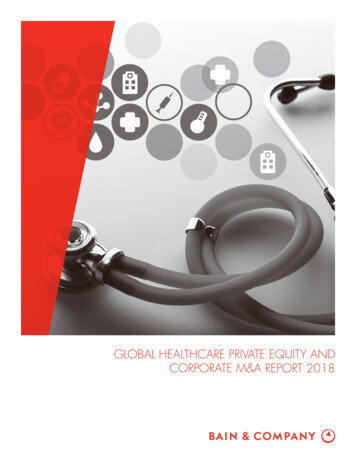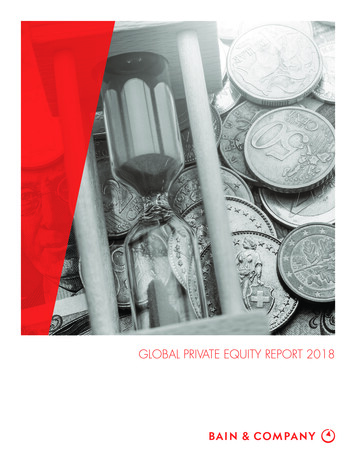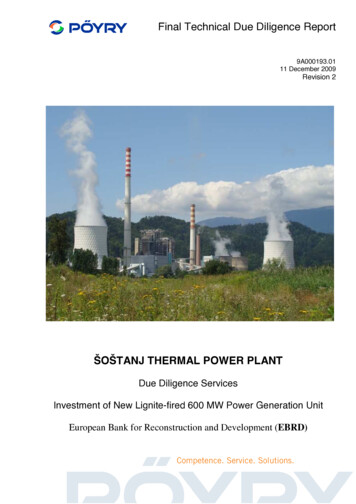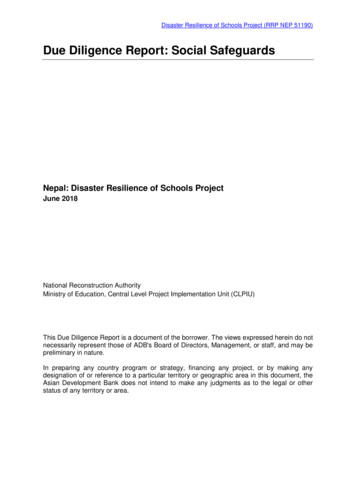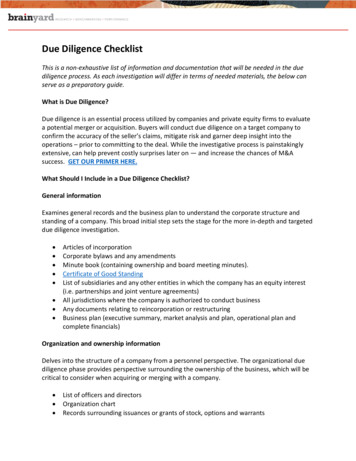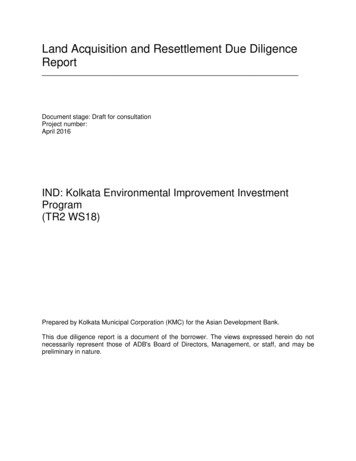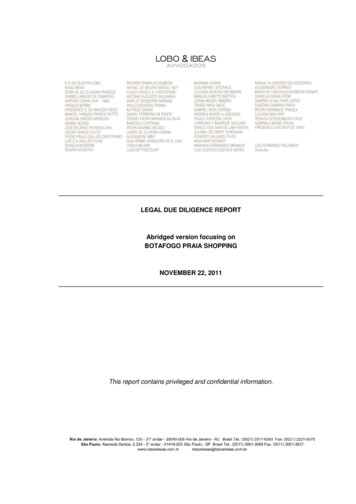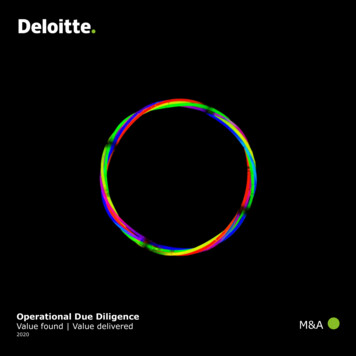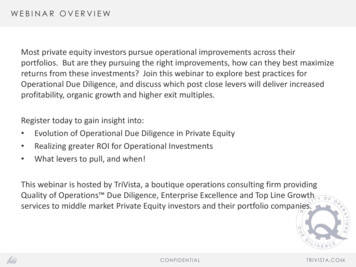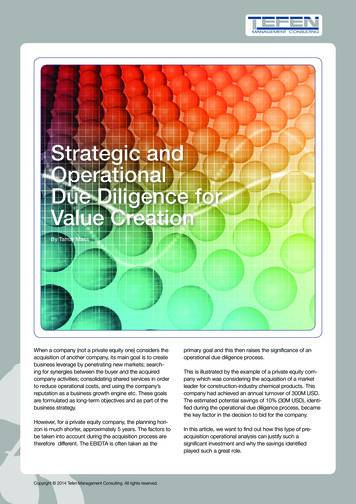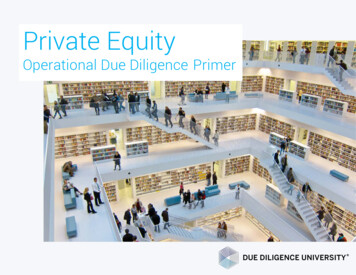
Transcription
Private EquityOperational Due Diligence Primer
IntroductionOperational due diligence is an established discipline for investorsallocating to hedge funds. Operational diligence on private equityvehicles is, however, a more recent initiative, driven by two key trends.First, institutional investors increasingly wish to implement aconsistent governance, risk and compliance oversight frameworkover all external managers, irrespective of asset class. As such, largeinvestors have begun to initiate similar diligence procedures withrespect to PE as compared to other manager relationships (suchinvestors also recognize the fiduciary implications of treating PE“differently” to other categories of manager). Second, a round of SECenforcement actions in the PE industry – including actions againstseveral top tier firms – have sensitized investors as to the need forcloser inspection of PE manager operational controls and broaderbusiness risks.This presentation provides an overview of diligence issues which canbe encountered in the PE industry. The presentation follows CastleHall’s OpsDiligence methodology, considering 10 core risk factors: Manager Compliance Information Technology Fund Asset Controls Trading Controls Valuation Controls Reporting Controls Operational Due Diligence Transparency2 — 20
Private EquityDue Diligence3 — 20
Management CompanyPrivate equity managers have the same “business risk” issues as any other external asset manager: Ownership structure (internal owners; external investors at management company level; some managers arepublically traded) Succession issues for initial founders (many PE firms are now facing generational succession issues) Assets under management (NB – it can be surprisingly difficult to calculate the correct AUM of a PE fund; itshould be calculated as the current value of active investments plus undrawn commitments. Many PE fundsreport the total aggregate value of capital raised across all vintage funds: this can (massively) overstate trueassets) Complexity of product range; potential overlap and conflicts between different products (e.g. venture to middlemarket to buy out to credit). Some PE firms may also run public market portfolios Extent of co-investment activities – do large and small investors in the same fund all have transparency as toco-investment activities? Financial viability of the management company if older vintage funds are “rolling off” Insider investment / alignment of interest. How much is the manager’s commitment (the GP commitment). Isthis funded in cash, or is it funded through fee waivers? (this is a US tax avoidance technique; funding issuesaround GP commitment were also central to the failure of Abraaj) Adequacy of internal resources (operations; fund accounting; compliance; information technology) Staff turnover4 — 20
ComplianceCompliance issues include: Regulatory oversight Results from regulatory inspections (if any). It is more common for PE managers to seek to restrictaccess to SEC inspection letters In the US, the SEC has raised a number of enforcement actions centering on inadequate disclosureof fees, notably around accelerated monitoring fees and related factors (See Appendix) Internal compliance polices Compliance documentation / compliance manual should be comprehensive and match “publicmarket” standards Potential conflicts of interest (e.g. allocation policies when multiple funds co-invest in the sameasset; what happens if a subsequent fund makes a follow on investment in an asset held by anearlier vintage fund; sale / purchase of investments between funds) Controls around manager executives personally investing in portfolio companies MNPI / non public information: note cases of insider trading around “take private” transactions Personal trading controls (typically limited, even when firms trade public securities post IPO) Controls when executives sit on the boards of investee companies (especially when those investeecompanies have gone public) Actions / claims and investigations versus the management company and executives. We stronglyrecommend comprehensive background checks when considering any PE manager5 — 20
InformationTechnology Many PE Managers have relativelyundeveloped IT systems given thattheir strategies are not transaction /data intensive Internal IT resources versus reliance on external ITproviders Ensure existence of BCP / disaster recoveryplan. Is the plan tested? Cybersecurity: Adequacy of cybersecurity policy Penetration tests / phishing tests etc.may not be completed systematically Has the Manager considered cyber risksat the portfolio company level?6 — 20
FundFund Structure Structures can be extremely complex due to the use of “Alternative Investment Vehicles” and parallel holding vehicles.SPV’s may be created in numerous jurisdictions. Financial Statements may be presented on a “combined” basisGovernance As a limited partnership, a typical PE vehicle does not have a board of directors: the fund is controlled by the generalpartner, being the manager. Governance standards therefore fall significantly short of typical hedge fund standards The effectiveness of the LPAC depends on the terms of reference - in some cases, the LPAC may be given theopportunity to review potential conflicts of interest only on the basis of transactions, presented to the LPAC by theManager (GP) for consideration. This can give the Manager the ability to be selective as to which transactions will bepresented for review The veto power / general authority of the LPAC is often unclear. Moreover, LPAC members generally do not wish toassume any managerial function and avoid any liability for decision making Transparency as to issues considered by the LPAC for investors who are not on the LPAC may be limited LPAC members are usually front office investment professionals from major investors – they are not lawyers /accountants able to opine on the legal and accounting issues which are most likely to be sent to the LPAC for“approval” There is clear conflict of interest if the same LPs serve on multiple funds: the LPAC members on Fund VII areeffectively ”self dealing” if they approve to buy an asset from Fund IV, where they are also on the LPACWe are, in general, disappointed with the quality of “watchdog” oversight provided by most LPAC structures. Lookingforward, we believe that more effective corporate governance is a material priority for the PE industry
FundFees Organizational costs are often very high (although typically subject to an ultimate cap). Org costs usuallyinclude fund raising, including travel to visit potential investors Other fees which can be charged to a fund are often high, including research related travel (large fundstypically allow private aircraft). It is also relatively common for the costs of internal manager staff (e.g.lawyers) to be charged to the fund under certain circumstances Key is the management fee offset: it has become more common for PE companies to acknowledge investorconcerns and allow some categories of other fee income (e.g directorship fees earned from portfoliocompanies) to be offset against the management fee. However, this is not universal, and in some cases theamount of the offset is limited (e.g. to 50% or to a maximum level) Other sources of income can be material for a PE manager – notably advisory fees, consulting fees,monitoring fees, transaction fees etc. etc. charged by the PE manager to portfolio companies as part of the“value creation” process There have been several cases where the SEC has brought actions against private equity managers in relationto misallocation of fees between the management company and funds (See Appendix)8 — 20
Asset ControlsPrivate assets are typically not “custodied”; private equity investments / related debt instruments are typically evidenced bycontracts. Controls to ensure that underlying assets are actually bona fide and genuinely exist are key. What controls are in place to ensure that assets purchased exist / are bona fide (e.g. if a firm invests 100m in anemerging market company, what controls are in place to ensure that the asset is plausibly “worth” 100m?) What controls are in place to ensure that no cash transfer is undertaken unless back office (and ideally third partyadministrator) personnel have accessed independently sourced documents to validate that transactions are bona fide? Oak Investments: example of an existence fraud (senior investment professional involved – see Appendix) Administrators, even when appointed, may rely on information forwarded by the manager, not gathered independently Audit comfort: auditors may not complete a 100% circularization to independently verify asset existence (especially inrelation to private debt / lending strategies)Cash transfers Ideally, cash transfers should be controlled by a third party custodian / administrator / trustee In house, cash transfers should always require dual signatures with appropriate segregation of duties. Cash balances maybe held at multiple institutions across various jurisdictions, with different signing authorities, at the SPV level PE may use less familiar financial institutions: Silicon Valley Bank is particularly popularUse of subscription credit lines is both popular and controversial: by funding with a line of credit in advance of calling capital, fundscan potentially boost IRR at the cost of additional interest payments.
Trading ControlsThe central issue for many private equity funds is the lack of athird party administrator. As a result, accounting records areregularly maintained in house (this is very common with respectçto US PE managers; it is less common for European and Asianmanagers, where administrator oversight is more typical). Quality of accounting records varies enormously –even multi billion dollar US managers may still useExcel within their back office accounting platform Allocations of management company expensesbetween multiple different funds can be complex.Multiple SEC enforcement actions (see Appendix)illustrate elevated risk in this area Separate accounting records may not be maintainedfor all SPV entities The size, experience level and qualifications ofinternal accounting teams is also highly variable10 — 20
ValuationIn a closed ended structure, valuation issues do not affect subscriptions and redemptions. However, valuation remainscritical to (1) provide an accurate track record for managers as they raise subsequent funds (see Oppenheimerenforcement action) and (2) to enable investors to accurately report their own performance. As already discussed, appointment of administrators is very mixed in the PE space; moreover, administratorsgenerally disclaim responsibility / decline to become involved in PE portfolio pricing Best practice universally includes the appointment of a third party valuation agent. In particular, the agentshould be engaged to independently value securities (not only review / verify a manager’s pricing under someform of “negative assurance” engagement). Pricing inputs should be gathered direct from underlying portfoliocompanies, not received via the manager. Practices in these areas, even from “top tier” valuation agents, varysignificantly (the same valuation agent may have materially different procedures client to client) Auditors do not universally gather valuation information from underlying portfolio companies. An auditorrelying on pricing inputs given to them by the asset manager provides an opportunity for valuation fraud The manager should establish a clear valuation policy. PE valuation policies are typically vague and unspecific(e.g. a generic policy stating that securities may be valued, at the GP’s discretion, using a combination oftransaction values, market multiples, and discounted cash flows) The manager should establish a valuation committee. The committee (voting members) should comprise amajority of back office professionals. Meetings should be minuted Pricing models should be “owned” by back office professionals: many PE firms continue to pass valuationresponsibilities to front office deal teams. Models should be consistent (e.g. weightings of market multipleversus cash flow approach). Inputs should also be consistent (e.g. discount rates, time horizons etc.)11 — 20
Reporting ControlsAs noted, many US PE funds do not appoint a fund administrator. Best practice universally callsfor appointment of a third party administrator for all PE funds: in particular, an effective admin canadd significant value when dealing with reporting control issues. Many self administered PE firms use Excel as their primary “accounting” platform withrespect to investor reporting. All capital call notices / distributions may be preparedusing Excel and “mailmerge”. An administrator can ensure that all notices are preparedin a systemic environment Even when an administrator is appointed, the investment manager may prepare theirown investor statements, or take statements from the administrator and post them totheir own IR portal. Failure for the administrator to independently distribute investorstatements would be unthinkable in a hedge fund environment Our experience suggests that fee waterfall calculations are often poorly controlled inthe PE industry. Many firms continue to rely on Excel spreadsheets (e.g. a fund with 56LPs has a spreadsheet with 56 separate tabs for each LP). Once more, an administratorshould be appointed to ensure that there is reliable, accurate oversight over all waterfallcalculations12 — 20
Operational Due DiligenceOperational Due Diligence applies to private equity fund of funds together with firms which may buy portfolios of assets ina secondary transaction. Private equity fund of funds do not universally complete background checks on each underlying manager andrelated key executives. There continues to be a sentiment that private equity is "relationship" and "partnership"based, and that the fund of funds may have known an underlying general partner for many years. In all cases,comprehensive background checks must be performed to vouch educational and employment history, confirman absence of legal actions (civil and criminal), and confirm absence of adverse media The PE fund of funds should mirror best practices in the hedge fund of funds business, establishing a cleardue diligence policy to address onsite diligence for new manager relationships, diligence for new "re-ups" withexisting managers, and then ongoing due diligence procedures for invested positions Investors should determine whether the fund of funds has a dedicated operational due diligence function (inhouse or external), separate from investment professionals13 — 20
Transparency Transparency is a material issue in the PE industry PE managers are more likely to push back on investordiligence questionnaire requests, impeding investor ability togather consistent information across all external managers Certain managers – especially in the Venture Capital space– believe that they should not “allow’ investor ODD. Stagemanaged investor “diligence days” are not unknown Access to key ‘trust but verify’ documents (e.g. SEC letters,valuation committee minutes, accounting spreadsheets,valuation reports etc.) may be limitedFor investors, limited transparency from PE managers may createfiduciary liability problems: how does the investor becomecomfortable with a manager who does not permit “standard” ODDprocedures?14 — 20
AppendixCastle Hall gathers information on investment industry operational failures, enforcement actions, fines and frauds within our "DiligenceEvent"database. Examples of "events" in the private equity arena which can inform investor due diligence include: Oppenheimer FundsAugust, 2013: The Securities and Exchange Commission today charged a former portfolio manager at Oppenheimer & Co. with misleadinginvestors about the valuation and performance of a fund consisting of other private equity funds.An SEC investigation found that Brian Williamson disseminated quarterly reports and marketing materials to prospective investorsmisstating that the valuation of the Oppenheimer fund’s holdings was based on values received from the portfolio managers of thoseunderlying funds. Williamson actually valued the fund’s largest investment at a significant markup to the manager’s estimated value. Healso sent marketing materials reporting an internal rate of return that failed to deduct fees and expenses. As a result, the fund’s reportedperformance as measured by its internal rate of return – a key indicator of the fund’s performance – was significantly enhanced. Oak PartnersAugust, 2015: The Securities and Exchange Commission obtained a preliminary injunction freezing assets of Iftikar Ahmed, an investmentprofessional charged with a 10-year running fraud at the venture capital firm where he previously was employed, Connecticut-based OakInvestment Partners. The SEC filed its emergency action against Ahmed in May 2015 and alleged that he obtained approximately 65 millionin ill-gotten gains.The SEC alleges that Ahmed used a variety of fraudulent devices to perpetrate his scheme and generate illicit profits in connection withnumerous securities transactions on which he advised Oak and the Oak funds. Among other things, Ahmed overstated the prices ofinvestments in companies that he presented to Oak, including by altering deal documents, and pocketed the difference for himself. Ahmedalso used fictitious invoices for purported expenses related to Oak's investment in various companies, which he caused Oak or thecompanies to pay and, again, pocketed the profits. Ahmed attempted to conceal his fraud by directing that Oak and the companies makepayments to bank accounts that Ahmed claimed belonged to the counterparty to the deals, but which in fact Ahmed secretly owned andcontrolled. After directing his ill-gotten profits into these accounts, Ahmed subsequently transferred those funds into accounts held in hisname and the names of family members and other related entities.Oppenheimer Funds: anaOak Partners: 23324.htm15 — 20
AppendixRiordan, Lewis & HadenFebruary, 2018: The United States Department of Justice filed a complaint in intervention against Diabetic Care Rx LLC d/b/a Patient CareAmerica (PCA), a compounding pharmacy located in Pompano Beach, Florida, alleging that the pharmacy paid illegal kickbacks to induceprescriptions for compounded drugs reimbursed by TRICARE, the Department of Justice announced today. The government has also broughtclaims against Patrick Smith and Matthew Smith, two pharmacy executives, and Riordan, Lewis & Haden Inc. (RLH), a private equity firmbased in Los Angeles, California, which manages both the pharmacy and the private equity fund that owns the pharmacy, for theirinvolvement in the alleged kickback scheme.Accelerated Monitoring Fees TPG: December, 2017 Blackstone: October, 2015 THL: June, 2018 Apollo: August, 2016 See also "Spreading Sunshine in Private Equity" May 2014 speech by Andrew J. Bowden, Director, Office of Compliance Inspections andExaminationsRiodan, Lewis & Haden: armacy-private-equityTPG: pdfBlackstone: lTHL: pdfApollo: pdfSpreading Sunshine in Private Equity: ab.html16 — 20
AppendixFee Allocation Issues WL RossAugust, 2016: Between 2001 and 2011, WL Ross adopted an allocation methodology that resulted in WLR retaining a significant amount ofthose transaction fees for itself rather than allocating them to the WLR Funds to offset management fees. Specifically, WL Ross allocatedtransaction fees to the WLR Funds based upon their relative ownership percentages of the portfolio company – rather than on a pro-ratabasis – without disclosing this practice. As a result, WL Ross retained for itself that portion of the transaction fees that was based upon coinvestors’ relative ownership of the portfolio company, without subjecting such fees to any management fee offsets. By doing so, WL Rossreceived approximately 10.4 million more in management fees during this period. LincolnshireSeptember, 2014: The Securities and Exchange Commission charged Lincolnshire, a New York-based investment advisory firm, with breachingits fiduciary duty to a pair of private equity funds by sharing expenses between a company in one’s portfolio and a company in the other’sportfolio in a manner that improperly benefited one fund over the other.An SEC investigation found that while Lincolnshire Management integrated the two portfolio companies and managed them as one, thefunds were separately advised and had distinct sets of investors. Despite developing an expense allocation policy as part of the integration,it was not followed on some occasions, resulting in the portfolio company owned by one fund paying more than its fair share of jointexpenses that benefited the companies of both funds.Lincolnshire agreed to pay more than 2.3 million to settle the SEC’s charges.WL Ross: s.pdfLincolnshire: https://www.sec.gov/news/press-release/2014-20517 — 20
AppendixFee Allocation Issues KKRJune, 2015: The Securities and Exchange Commission charged Kohlberg Kravis Roberts & Co. (KKR) with misallocating more than 17 million in socalled “broken deal” expenses to its flagship private equity funds in breach of its fiduciary duty. KKR agreed to pay nearly 30 million to settle thecharges, including a 10 million penalty.An SEC investigation found that during a six-year period ending in 2011, KKR incurred 338 million in broken deal or diligence expenses related tounsuccessful buyout opportunities and similar expenses. Even though KKR’s co-investors, including KKR executives, participated in the firm’sprivate equity transactions and benefited from the firm’s deal sourcing efforts, KKR did not allocate any portion of these broken deal expenses to anyof them for years. KKR did not expressly disclose in its fund limited partnership agreements or related offering materials that it did not allocatebroken deal expenses to the co-investors. FenwayNovember, 2015: An SEC investigation found that Fenway Partners LLC, principals Peter Lamm and William Gregory Smart, former principal TimothyMayhew Jr., and chief financial officer Walter Wiacek weren’t fully forthcoming to the client and investors about several transactions involving morethan 20 million in payments out of fund assets or portfolio companies to an affiliated entity for consulting services and to Mayhew and otherformer firm employees for services they primarily provided while still working at Fenway Partners. Welsh CarsonApril, 2018: The SEC found that WCAS Management Corporation (WCAS), WCAS entered into an agreement (Agreement) with a company thatprovided services to portfolio companies owned by the private equity funds WCAS managed. Under the Agreement, WCAS received a share of therevenue the service provider received as a result of the WCAS portfolio companies’ purchases. Further, while negotiating the Agreement, the serviceprovider suggested it would enter into the Agreement if one of WCAS’s portfolio companies signed a separate agreement to purchase services fromthe provider’s affiliate. WCAS did not disclose these conflicts of interest to the fund investors, and could not effectively consent on behalf of itsprivate equity fund clients. WCAS received 623,035 under the Agreement, and voluntarily stopped receiving fees after the SEC began itsinvestigation.KKR: lFenway: lWelsh Carson: https://www.sec.gov/enforce/ia-4896-s18 — 20
AppendixFee Allocation Issues DyalDecember 2018: Per an SEC action, from 2012 through 2016, certain Dyal BSP employees did not work exclusively on providing services, advice andsupport to Partner Managers. Certain of those BSP employees spent a percentage of their time on tasks that assisted the investment team, such asraising capital for the Dyal Funds, as well as identifying and meeting with alternative asset management companies in which the Dyal Funds mightseek to invest. While some of those tasks may have incrementally benefited the Partner Managers, they did not involve providing services, support oradvice to Partner Managers in which the Dyal Funds already had invested. NBAA [Neuberger Berman Alternative Advisors] will disgorge 2,073,988and pay prejudgment interest of 284,620, which NBAA is required to distribute to harmed investors. NBAA also will pay a civil monetary penalty of 375,000.” YucaipaDecember 2018: Per the SEC, Yucaipa did not disclose to the funds its practice of charging the funds for the cost of certain in-house employees whoassisted in preparing the funds’ tax returns.Second, Yucaipa did not disclose its arrangements with two third-party service providers that resulted inexpense allocation decisions that posed actual or potential conflicts of interest. Lightyear CapitalDecember 2018: Per the SEC, Lightyear launched its first Flagship Fund in 2000 and its first Employee Fund in 2001. From that time through 2016,Lightyear allocated certain expenses, including broken deal, legal, consulting, insurance and other expenses solely to the Flagship Funds. Althoughthe Organizational Documents disclosed that the Flagship Funds would be allocated expenses incurred in connection with potential or actualFlagship Fund investments, Lightyear did not disclose in the Organizational Documents or elsewhere that the Employee Funds would not beallocated a proportional share of such expenses. Lightyear should have disclosed this conflict of interest in the Organizational Documents orobtained approval from the Flagship Funds’ Advisory Committees. Instead, Lightyear failed to disclose in the Organizational Documents orelsewhere that the Flagship Funds would pay all of the expenses in connection with the transactions, despite the fact that the Employee Fundsparticipated in and benefitted from the transactions. Lightyear also failed to obtain approval from the Flagship Funds’ Advisory Committees for thispractice. In the absence of such disclosure or approval, Lightyear should have allocated the proportional share of such expenses to the EmployeeFunds. The failure to allocate such expenses to the Employee Funds and the allocation of those expenses to the Flagship Funds benefittedLightyear’s Employee Funds at the expense of the Flagship Funds. As a result of Lightyear’s conduct, from approximately 2000 through 2016, theFlagship Funds paid approximately 167,000 more in expenses than they should have paid.Dyal: pdfYucaipa: pdfLightyear Capital: pdf
ZurichMarktgasse 12CH-8001 ZürichManilaSwitzerlandGround Floor, 41 (0)44 296 90 60TwoE–com CenterMall of Asia ComplexPasay City, Metro ManilaPhilippinesMontrealHalifax1080 Côte du Beaver Hall,84 Chain Lake Drive,Suite 904Suite 501Montreal, QCHalifax, NSCanada H2Z 1S8Canada, B3S 1A2 1-450-465-8880 1-902-429-8880Abu DhabiAl Maryah Island24th Floor Al SilaTower, Suite 2422Abu Dhabi GlobalMarket SquarePO Box 5100738Abu Dhabi, UAE 971 (2) 694 8510SydneyLevel 36 GovernorPhillip Tower1 Farrer PlaceSydney 2000Australia 61 (2) 8823 3370castlehalldiligence.com
Jan 07, 2019 · Operational due diligence is an established discipline for investors allocating to hedge funds. Operational diligence on private equity vehicles is, however, a more recent initiative, driven by two key trends. First, institutional investors increasingly wish to implement a consi
